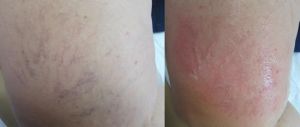Spider Veins, Varicose Veins, and Laser Therapy
Most people would like to remove their unsightly spider veins, but they are confused about spider veins and varicose veins: I will attempt to highlight the differences and similarities and why removing spider veins with laser therapy is so worth it. What are spider veins? What causes them? How do I prevent them? How do you treat them using laser Therapy?
What are spider veins?
To begin with, both spider veins and varicose veins are types of venous insufficiency. In other words, the one-way valves in the veins do not close properly as the blood tries to return to the heart, causing it to flow backwards. The blood collects or pools in the vein resulting in spider veins or, in more extreme cases, varicose veins. In both types of veins, the valves are damaged and do not close as they should.
Spider veins, also known as telangiectasia (red, thread-like veins) and venulectasias (blue veins close to the surface of the skin and less than 2mm in diameter), look like spider webs. In short, they are busted blood vessels close to the surface of the skin. Spider veins can be removed with the Nd:YAG laser such as the one we use at Nell Laser Clinic. Varicose veins are larger and deeper, usually lumpy, twisted and flesh-coloured. Some varicose veins, if they are tiny and close to the surface, can be removed by laser, but most of the time varicose veins require more extensive procedures- sometimes even surgery.
What causes spider veins?
Spider veins usually cause no pain or swelling, and they are typically removed for cosmetic reasons. Varicose veins, on the other hand, will cause pain, swollen ankles and legs as well as a heavy feeling in the legs. Unlike spider veins, varicose veins usually cause itchiness and discomfort.
Coughing, sneezing, vomiting (i.e., pressure), giving birth, and sun damage from ultraviolet rays can sometimes lead to spider veins. Certain circumstances will make some people more susceptible to spider veins (and varicose veins). Age, weight, family history, gender (females are more prone), menopause (higher levels of estrogen can weaken valves), and standing or sitting for long periods of time without taking a break to walk around (ideally every 30 minutes) can all lead to the condition.
How do I prevent them?
To prevent spider veins from getting worse there are some lifestyle changes you can make. Keep a healthy weight, don’t wear tight clothes, limit alcohol, elevate legs, move around, wear compression stockings, exercise, avoid hot tubs and saunas (they bring blood to the surface of the skin), and see your Skin Therapist if you have Rosacea.
How do you treat them using laser Therapy?
Laser Treatment is by far the easiest and least invasive way to remove spider veins. The Nd:YAG laser has a cool tip to prevent any burning. It is a hand-held device whereby the heat(photons) from the laser coagulates the blood, the vein collapses, seals and is eventually absorbed by the blood in your body.
The Treatment is not a walk in the park, but with technology so advanced there is nothing to worry about. You just need a little courage and determination. The cool tip makes the procedure a lot easier.
One week before the Treatment avoid the sun, aspirin, alcohol and smoking. No lotions or creams on the day of treatment and be sure to wear loose, comfortable clothing.
You will need 2-6 treatments scheduled 4-6 weeks apart, depending on the size and number of veins. The results are not immediate in most cases. Veins soon turn a light red and disappear within 2-6 weeks. Some veins may take longer, sometimes 6 months to a year.
Unfortunately, there is no cure for spider veins. They are usually recurrent, but the skin’s appearance is dramatically improved with laser Therapy. The result: no more unsightly spider veins!





